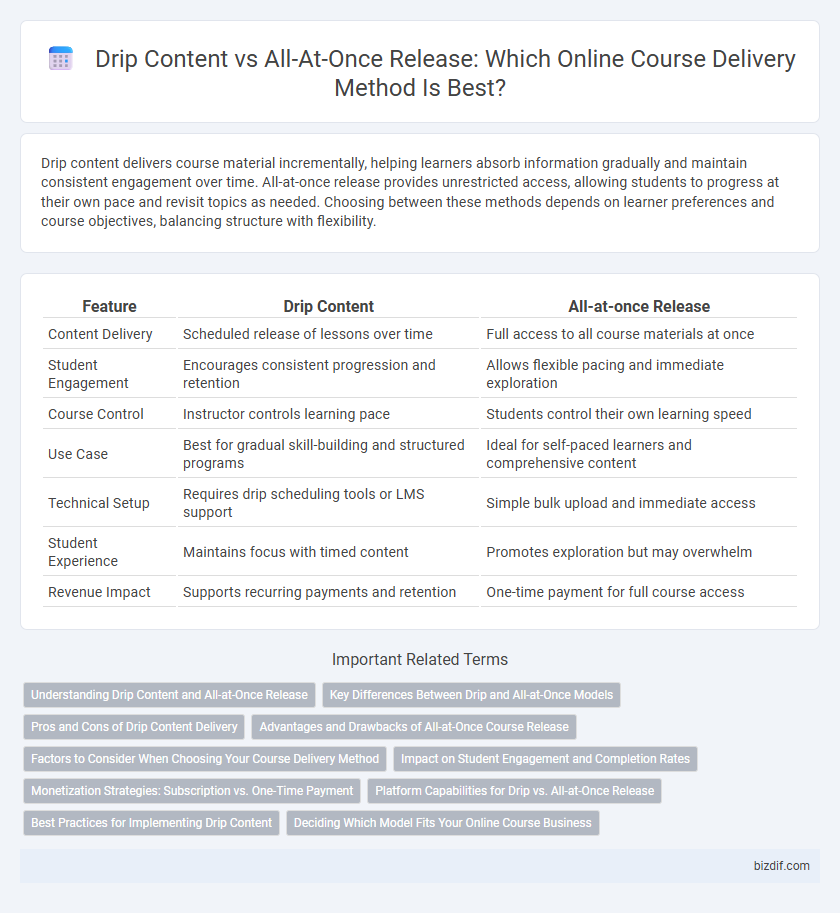Drip content delivers course material incrementally, helping learners absorb information gradually and maintain consistent engagement over time. All-at-once release provides unrestricted access, allowing students to progress at their own pace and revisit topics as needed. Choosing between these methods depends on learner preferences and course objectives, balancing structure with flexibility.
Table of Comparison
| Feature | Drip Content | All-at-once Release |
|---|---|---|
| Content Delivery | Scheduled release of lessons over time | Full access to all course materials at once |
| Student Engagement | Encourages consistent progression and retention | Allows flexible pacing and immediate exploration |
| Course Control | Instructor controls learning pace | Students control their own learning speed |
| Use Case | Best for gradual skill-building and structured programs | Ideal for self-paced learners and comprehensive content |
| Technical Setup | Requires drip scheduling tools or LMS support | Simple bulk upload and immediate access |
| Student Experience | Maintains focus with timed content | Promotes exploration but may overwhelm |
| Revenue Impact | Supports recurring payments and retention | One-time payment for full course access |
Understanding Drip Content and All-at-Once Release
Drip content delivers course materials incrementally over a set schedule, enhancing learner engagement and retention by pacing information absorption. All-at-once release grants immediate access to the entire curriculum, providing flexibility for self-paced learning but potentially overwhelming students. Choosing between these methods impacts course structure, student motivation, and completion rates in online course creation.
Key Differences Between Drip and All-at-Once Models
Drip content releases course materials incrementally over time, fostering consistent engagement and reducing overwhelm by pacing learner progress, while all-at-once release grants immediate access to the entire curriculum, enabling self-paced learning but risking procrastination. Drip models enhance retention through scheduled content delivery aligned with learning objectives, whereas all-at-once models appeal to motivated learners seeking flexibility. Choosing between drip and all-at-once hinges on course goals, learner preferences, and desired interaction levels.
Pros and Cons of Drip Content Delivery
Drip content delivery in online course creation allows for gradual release of material, enhancing learner retention and reducing overwhelm by pacing information absorption. This method fosters continuous engagement and better knowledge reinforcement compared to all-at-once release, which may lead to information overload and decreased motivation. However, drip delivery requires precise scheduling and limits learner flexibility, potentially frustrating those who prefer accelerated progress.
Advantages and Drawbacks of All-at-Once Course Release
All-at-once course release allows learners to access the entire curriculum immediately, promoting self-paced study and flexible scheduling, which can enhance engagement for motivated students. However, this method risks overwhelming users with information, potentially reducing retention and completion rates without structured guidance or milestone checkpoints. Course creators may also face challenges in maintaining consistent student interaction and providing timely feedback due to the asynchronous learning flow.
Factors to Consider When Choosing Your Course Delivery Method
Choosing between drip content and all-at-once release depends on learner engagement goals, course complexity, and content retention rates. Drip content facilitates structured pacing and sustained motivation by releasing material incrementally, while all-at-once release offers flexibility, allowing learners to progress at their own speed. Factors like audience preferences, course length, and assessment frequency critically impact the optimal delivery method for maximizing course effectiveness.
Impact on Student Engagement and Completion Rates
Drip content delivery enhances student engagement by pacing material release, encouraging consistent progress and reducing overwhelm, which often leads to higher completion rates. In contrast, all-at-once release offers flexibility but can result in procrastination and lower course completion due to lack of structured guidance. Studies indicate drip content increases active participation by up to 40%, highlighting its effectiveness in sustaining learner motivation throughout the course.
Monetization Strategies: Subscription vs. One-Time Payment
Drip content supports subscription monetization by providing ongoing value that encourages longer customer retention and predictable recurring revenue. All-at-once release aligns with one-time payment models, appealing to buyers seeking immediate access and upfront ownership without future commitments. Choosing between these strategies depends on targeting customer preferences for engagement duration and payment flexibility in online course markets.
Platform Capabilities for Drip vs. All-at-Once Release
Platform capabilities for drip content typically include automated scheduling, progress tracking, and timed access controls, allowing creators to release lessons incrementally to enhance learner engagement and retention. In contrast, all-at-once release platforms prioritize immediate access, supporting bulk content uploads and flexible navigation but may lack granular control over lesson pacing and timely content delivery. Choosing between drip and all-at-once release hinges on platform features that align with course design goals, such as adaptive learning pathways for drip or learner autonomy for full access.
Best Practices for Implementing Drip Content
Implementing drip content in online courses enhances learner engagement and knowledge retention by delivering modules incrementally over time. Best practices include scheduling content releases based on learner progress and embedding quizzes to reinforce understanding at each stage. This method supports consistent study habits and reduces overwhelm, leading to higher course completion rates and improved student outcomes.
Deciding Which Model Fits Your Online Course Business
Choosing between drip content and all-at-once release depends on your course goals and audience engagement strategy. Drip content delivers lessons progressively, fostering sustained student interaction and reducing overwhelm, ideal for courses requiring skill-building over time. All-at-once access suits learners who prefer self-paced study and immediate content availability, benefiting courses aimed at rapid knowledge acquisition or professional development.
Drip Content vs All-at-once Release Infographic

 bizdif.com
bizdif.com